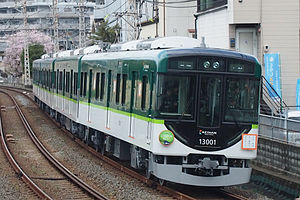Keihan 13000 series
| Keihan 13000 series | |
|---|---|

Set 13001 on the Uji Line in April 2012
|
|
| Manufacturer | Kawasaki Heavy Industries |
| Built at | Kobe |
| Family name | City commuter |
| Replaced | Keihan 2600 series |
| Constructed | 2013– |
| Entered service | 14 April 2012 |
| Number built | 38 vehicles (8 sets) |
| Number in service | 38 vehicles (8 sets) |
| Formation | 4/7 cars per trainset |
| Fleet numbers | 13001– |
| Capacity | 540 |
| Operator(s) | Keihan Electric Railway |
| Line(s) served | Keihan Uji Line, Keihan Katano Line |
| Specifications | |
| Car body construction | Aluminium alloy |
| Car length | 18,900 mm (62 ft 0 in) (end cars) 18,700 mm (61 ft 4 in) (intermediate cars) |
| Width | 2,792 mm (9 ft 1.9 in) |
| Doors | 3 pairs per side |
| Maximum speed | 110 km/h (70 mph) |
| Traction system | variable-frequency |
| Acceleration | 2.8 km/h/s |
| Deceleration | 4.0 km/h/s (service), 4.3 km/h/s (emergency) |
| Electric system(s) | 1,500 V DC |
| Current collection method | Overhead wire |
| Bogies | KW-77D (motored), FS577 (trailer) |
| Safety system(s) | Keihan ATS |
| Track gauge | 1,435 mm (4 ft 8 1⁄2 in) |
The Keihan 13000 series (京阪13000系 Keihan 13000-kei?) is an electric multiple unit (EMU) commuter train type operated by the private railway operator Keihan Electric Railway on the Keihan Uji Line and other lines in Kyoto, Japan, since April 2012. The initial order consisted of five 4-car sets, intended to replace 20 life-expired 2600 series vehicles, and as of 1 April 2015[update], the fleet consists of six four-car sets and two seven-car sets.
The overall design concept draws on the design of the 3000 series EMU trains introduced from 2008.
The new trains include energy-saving and environmentally friendly features. The 13000 series trains will use 35% less power than the 2600 series they are intended to replace, and produce less environmental noise in service. The cars feature aluminium alloy bodies with a semi-double skin construction, and incorporate increased crash resistance.
The end cars are each equipped with one PT-4805-A scissors-type pantograph recycled from withdrawn rolling stock.
Internally, LCD passenger information screens are provided above doorways.
Longitudinal bench seating use contoured "bucket seats" with a width of 470 mm (19 in) per passenger.
Luggage racks are lowered by 20 mm to a height of 1,750 mm for accessibility, with the racks above priority seating lowered 50 mm to a height of 1,720 mm.
The interior flooring design is intended to evoke an image of Kyoto's traditional stone-paved streets.
The 2nd-batch sets, 13006 onward, use LED lighting.
Interior of a 13020 series set, June 2014
7-person bench seat
Sliding doors and LCD passenger information screen
As of 1 April 2015[update], the fleet consists of six four-car sets (13001 to 13006) and two seven-car sets (13021 and 13022), formed as follows, with the Mc1/Mc3 cars at the Kyoto/Uji end.
...
Wikipedia
